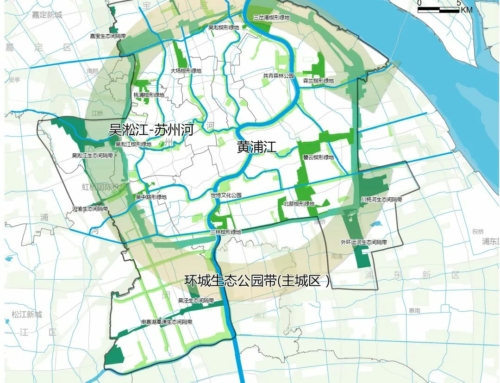Trillions of dollars of climate finance need nature to be machine-like. But nature is not a machine. So how shall we proceed? In this 20′ talk, I explore two questions: Can AI serve all of life, not just human life? And if so, how?
BACKGROUND TO THIS TALK
In Shanghai, at the invitation of Prof. Dr. Yongqi Lou (President of Shanghai University of Engineering Scienc) I’ve been developing developing the agenda for a Thematic Cluster around the agenda of Regenerative Design. My job is to identify opportunities where Regenerative Design meets climate finance, artificial intelligence, ecological restoration, green infrastructure, and agro-ecology. The work builds on the bioregioning agenda, and the Urban-Rural expo we did at the end of 2019.
Transcription: From Green Design to Ecological Design, Beyond Calculation
Good data are important if we are to understand and reverse the destruction of nature that’s so distressing to us all. And it is good news that more and more data about biodiversity is becoming available thanks to the marvels of satellite imagery, DNA analysis, and other data analysed by AI.
But is artificial intelligence enough, on its own, to drive the ecological transition we so desperately need?
My key point today: AI can be a support for transformational change. But a truly just transition will only happen when, in the words of Raimon Pannikar, we “see nature differently, relate to nature differently, and understand our purpose here differently”.
Seventy five years ago, in 1944, the science fiction writer Isaac Asimov published his First Law of Robotics. It stated: “A robot may not injure a human being nor, through inaction, allow a human being to come to harm”.
Around the world, numerous groups have puiblished ethical principles for AI. By one estimate, 172 statements have been published so far. China’s version is aligned with most of the other statements: AI should be re-oriented in the service of human good.
If we think of Artificial Intelligence as a kind of robot, then Asimov’s law could easily be updated: “AI may not injure a human being nor, through inaction, allow a human being to come to harm’.
There’s been more disagreement about implementation of such a law. How can we ensure, experts ask, that AI systems will understand what we mean? Do what we want? This question, too, has a history. Back in 1960, the mathematician Norbert Wiener asked, “Are we quite sure that the purpose put into the machine is the purpose which we really desire?.”
That one word – ‘purpose’ – highlights the core dilemma that I will focus on today.
Because even if we could be sure that AI would understand and obey an updated Asimov law, such a law would only mention “what’s good for humans” . There’s no mention of all the other life forms we share the living planet with. This humans-first approach has had catastrophic consequences throughout the industrial age.
Even before AI came along, “what’s good for humans” helped shape an economy that extracts vitality, as well as resources, from the planet’s living systems.
This cultural disconnection – between the living world, and the economic one – explains why we either don’t think about rivers, soils, and biodiversity at all – or we treat them as natural ‘resources’ whose only purpose is to feed “the economy.”
The idea that “the economy” exists in a separate domain from life itself sounds crazy when you say it out loud.
By the same token, It makes little sense to discuss the purpose of AI in isolation from the bigger picture of life on earth, and our place within that.
President Xi alluded to the need for a larger purpose just a few days ago. In a speech about the Belt and Road Initiative, he called for a “new development paradigm”.
This idea – a new concept for development – is for me the best place to start in any discussion of where and how we use AI.
New development paradigm
We need to ask, first: What are the social and ecological objectives of development? and, within that framework, How can AI help us achieve them?
For me, “new development paradigm” means development that helps all of life thrive – not just human life. It means: Enable natural systems to endure. It means: Beneficial relations between ecosystems.
How would AI help us achieve this?
I believe that AI – used together with science, design, and art – can be a medium of experience and learning that can help us realise that nature, and the economy, are not two different places. Everything in the living world is connected
AI can support a learning process that re-awakens our capacity for ecological thinking – and help us “see” the life that surrounds us – but invisibly.
There are positive developments along these lines in the worlds of AI and Machine Learning.
In 2019, Machine Learning heavyweights from GoogleAI, Deep Mind, Stanford, Carnegie Mellon, ETH Zurich and others published this 111-page report “Tackling Climate Change With Machine Learning”.
Their report included a comprehensive list list of “Climate change solution domains” . These range from remote sensing, to the rededsign of financial markets.
It’s a long list, but one theme united these experts: If we’re going to manage the climate crisis – if we’re going to find “solutions” – then we need more data” !
Global demand for environmental data was supercharged two weeks ago at COP26 in Scotland.
Mark Carney announced that 130 trillion dollars in climate finance commitments had been promised by various financial actors. The mysterious acronyms he used disguise a lot disagreement about what counts as climate finance, what the money is for, and who gets to spend it.
But Carney made one point clear in plain language: this money would prove hard to distribute in the absence of metrics and verification.
Carney’s announcement can only increase the search for climate disclosure metrics. A.I. is being promoted as a global observation platform that monitors ecosystem health at multiple scales – from the planetary, to the microscopic.
Planet Labs, on a larger scale, have deployed a swarm of Earth-observing satellites that can monitor every forest, every tree, and every city block, everywhere on Earth, on a daily basis.
This real-time ecological dashboard, say Planet, can enable forest managers to see the signs of deforestation as they are occurring – as opposed to long after.
Its satellites can also spot but also detect the precursors of deforestation they say – such as the establishment of illegal roads that tend to appear before trees are illegally harvested.
Another big project, Microsoft’s AI For Earth, give people the power to make accurate climate predictions using artificial intelligence tools.
In England, researchers at Exeter University are training AI systems to classify all this raw data – from sensors on the ground, in the sky, or in space.
Integrating data and information from multiple, inter-related, sources, they claim, affords better understanding of complex interactions between the climate, natural ecosystems, human systems, the economy, and health.
In Switzerland, the Crowther Lab has launched an open data platform, Restor, that connects everyone, everywhere, to local restoration.
Restor connects people to scientific data, supply chains, funding – and each other – to increase the impact, scale, and sustainability of restoration efforts.
“We believe that anyone can be a restoration champion” they say, “ including you”
Bird research is also being transformed by Artificial Intelligence. The BirdNET platform, for example, combines bioacoustics with an AI based algorithm to automate bird species recognition from acoustic data.
Citizen science has radically expanded the scale of data collection: birdwatchers have contributed than 140 million observations
In Germany they use eDNA metabarcoding to analyse the health and diversity of insect populations.
Soils are the most complex microbial ecosystem we know. A single teaspoon of healthy soil may contain thousands of species, a billion individuals, and one hundred metres of fungal networks. The soils in forest ecosystems, especially, are a foundational part of the global carbon cycle. But to most of us in the modern urban world, they’ve been invisible and uncared for.
Julian Liber studies the rhizosphere – the soil around the root of plant where microbial activity is especially high. Helped by AI, he tracks fungal hyphae – their rate of growth, how often they branch, and other metrics.
The number and vitality of worms is another good indicator of soil health. Thanks to machine learning, observations from diverse sources can now be used to make diagnostic maps.
Fish farming is investing heavily in sensors and AI tools. Some of these systems can even even monitor what they eat.
Another agricultural process, composting, transforms organic waste to nutrient-rich manure. But composting infrastructures tend to be installed away from residential areas. This makes tending to the compost heap a tedious task.
Thanks to compost monitors, Internet of Things, and AI, composting has now become a more viable as an urban activity.
The scale and scope of biodiversity sampling is being expanded dramatically by small, low-power computing devices, advances in wireless communications, and data-recognition algorithms in the field of machine learning. AudioMoth, for example, is being used to understand the world of bats in real time.
These efforts are vital in efforts to prevent another Covid. Researchers at the Chinese Academy of Sciences are using AI-supported bioacoustics to plot the distribution of bat species.Their aim is anticipate any danger of ‘spillover’ – from wild into urban – as a result of habitat disturbance by human activity.
But let me return to the core issue of PURPOSE of AI and the new development paradigm mentioned earlier.
The restoration of ecosystems damaged by decades of extraction is surely central to that over-arching purpose. AI, here, can play a important role in identifying restoration options that diversify the local economy, and create jobs. For example, the use of fiber crops to remediate degraded land and provide future livelihoods.
In Australia, where numerous mine sites are being rehabilitated back to their native ecosystems, eDNA metabarcoding helps ecologists determine what insects, pollinators, and bacteria used to live there, and so what should be planted there, next.
Add all these experiments together, and the tools and connectivity are within our grasp, today, to monitor every patch the vital signs of of the planet in real time.
We could repurpose the giant screen used by Alibaba to monitor sales during Black Friday. We could feed in data – from satellites in space, to microbial communities surveyed by eDNA.
We’d get a wondrous insight into the health of planet – place by place, patch by patch.
But there’s a dilemma here. A new dashboard is not the same as a new system.
On the contrary. For most if the world’s economic and political actors – the ones that will spend $100 trillion of climate finance announced by Mark Carney – the climate crisis is not a system failure – it’s a problem of management, efficiency, and control.
All those promises to plant billions of trees? A Yale study found that 45% of these trees, planted “efficiently”, will be monocultural plantations – managed as cash crops and devoid of biodiversity.
That’s the problem with the dashboard idea. It frames the living world as some kind of machine to process “natural resources” and “ecosystem services”.
Returning to Mark Carney again: that tsunami of climate finance could actually increase ecological destruction.
Demand for carbon offsets, net-zero, and nature positive credits, is escalating. And in order to meet this demand on a large scale, investors demand standardised metrics in order to simplify and speed up verification.
But biodiversity is the literal opposite of standardised.
The best indicator of biodiversity health is diversity, continuous adaptation, and change. The health of an ecosystem lies in the vitality of interactions between its component species.
The study of living systems tells a consistent story. Whether it’s sub-microscopic viruses, mosses, and mycorrhizae – or trees, rivers and climate systems – science has confirmed an ancient wisdom: All natural phenomena are not only connected. Their very essence is to be in relationship with other things -including us.
The health of the soil, microbes, soil, plants – and the health of people – are a single story. Diversity and adaptation are the best indicators of vitality.
No matter how massive the datasets and simulations created by AI, computational models cannot comprehend the complexity and interdependence of ecosystems. They will remain just that: models of reality.
The bank Credit Suisse, with remarkable candour, has put it best: ”biodiversity is the anti-commodity”.
This is bad news for an industrial economy that that treats raw materials as commodities.
In an industrial system, efficiency and control are success factors. The system demands uniformity and standardisation. Diversity, of the kind found in healthy nature, makes the game impossible.
And this is why climate finance could make things worse.
Every social and ecological context is unique – but finance needs the living world to behave like a machine – like the tree plantations I mentioned earlier.
The inherent complexity of nature is confirmed by real-world restoration projects – especially in the world’s critical zones. To monitor their vitality, scientists have established critical zones observatories throughout the world including this one in China.
Yes, they use sensors and highly technical instruments to collect data in these outdoor laboratories. But making sense of this complex data involves multiple skills.
AI can help with interpretation, but the story on the ground remains complex.
As well as the diverse scientific disciplines, ecological restoration can often involve dozens of organisations. This social and organisational dimension further intensifies the complexity.
And as my colleague Professor Lou Yongqi has explained, social systems are just one among four that we have to contend with: Nature, Human, Artificial, and Cyber.
As well as involving multiple systems, real-world ecological restoration also involves multiple timescales.The timescales of restoring land, measured in decades, are way beyond the ultra-fast tempo of financial markets that can be measured in milliseconds.
If finance needs nature to be machine-like – but nature is not a machine – how best are we to respond?
I believe designers are well-placed to help us cope with this tangled dilemma .
Learning from the last 50 years, it’s surely clear that we don’t need more messages, concepts, instructions. What we need, and what we yearn for, is connection – connection with each other; connection with place; and above all, connection with the living.
Designers can use their creative skills to represent social and natural systems immersively. In so-called ‘system in the room’ intallations, we humans can experience being part of nature, not outside.
The word, experience, I believe, is key. AI, as I’ve shown, can provide extraordinary data and insights – but something more is needed to awaken the experience of interconnectedness.
Design-plus-AI can be a medium of attention – such as with ecosystems we have neglected; a medium of connection – so we don’t just look; a medium of relationship with the living world that can persist through time
Beyond Calculation
The destruction will stop when we stop thinking of the oceans, fields and forests as ‘resources’ or ‘solutions’ – and start thinking (and acting) in them as lifeworlds.
Making that shift is the basis of a new way to measure and create value, and therefore purpose. That’s why we need to experience the health of a place, and of the persons who inhabit it, as a single story.
Such a change of course requires ecological literacy, and a whole-systems understanding of the world. AI, art, design, I believe, can help us acquire these skills and understanding.
end




